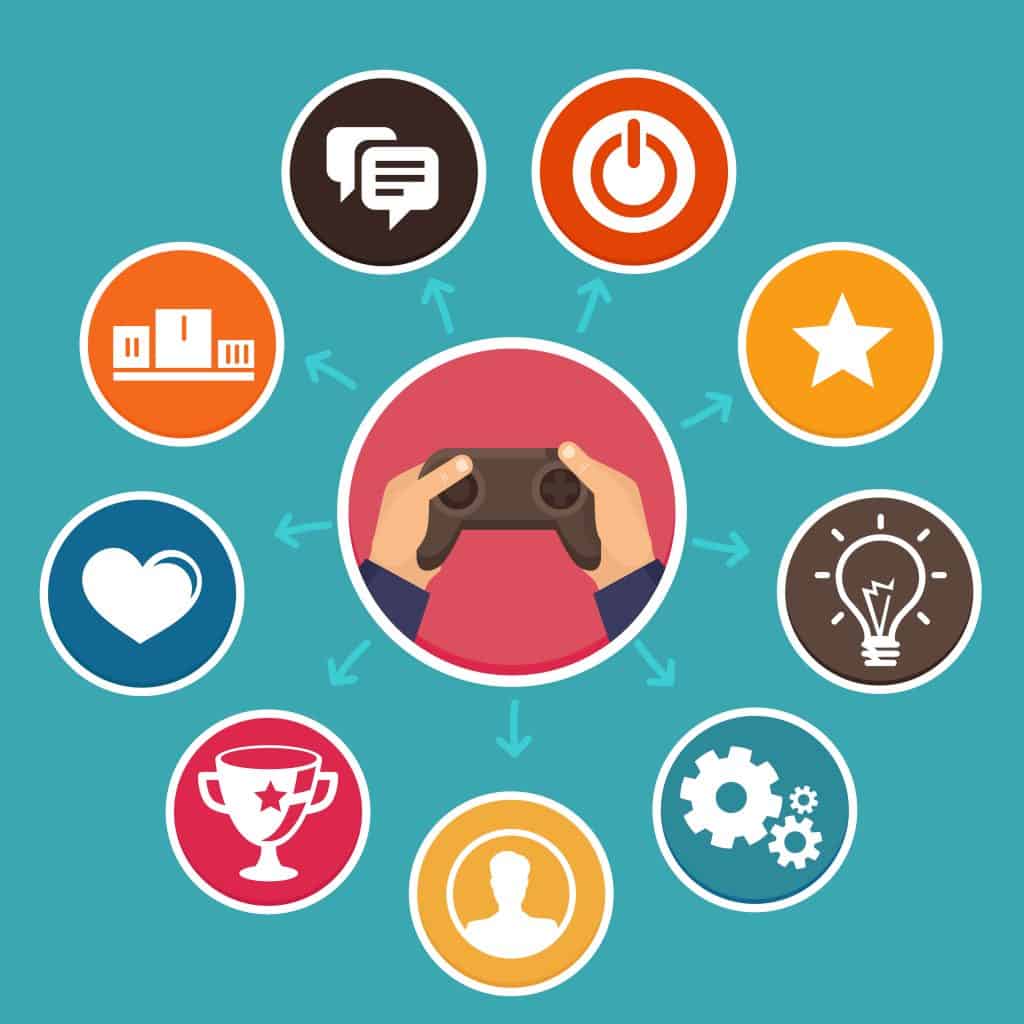Home » Gamification

Gamification is the process of using game elements into a non-game context. Many companies have used Gamification in company apps, community forums, websites, and more. The goal of Gamification is to engage and motivate players to achieve organizational goals. These goals are set up to align with business goals and values to help players best serve the larger community.
Gamification, also known as “Game Thinking” is more than just creating a game for recreation. While games should always be fun, Gamification creates business-oriented fun that applies gaming elements to existing practices, processes, and standards. These elements work together to offer visible paths of advancement and success. Whether companies apply Gamification to digital or non-digital products and organizations, it offers an easy way to motivate employees or players. The end results are higher profitability, better customer and employee engagement and retention, as well as improved employee health and morale.
We know that Gamification elements motivate and engage players. Companies have experimented with ways to use these elements to achieve long-term goals for their bottom line.
But what are some of the Gamification elements you can use in your company?
Here are the most essential Gamification elements for motivating and engaging businesses:

In games, the more points you have, the higher you rank on leaderboards. With Gamification, you award points to players when they complete quests or assignments, earn achievements, or show a record of encouraged behaviors including punctuality. Points offer immediate feedback and have a positive effect on the brain’s reward system. Gamification offers incentive to collect points by offering a means of tracking rewards, building a reputation, and inspiring achievement.
Many games use badges for visualization of achievement and successful completion of goals. Gamification uses badges to motivate employees to behave in certain ways. You can award badges for earning points, accomplishing specific goals, or to celebrate long-term engagement and loyalty. Employees can have profile pages to display their collected badges for a sense of pride as well as bragging rights with their fellow employees.
In games, levels are a way of qualifying experience and mastery. With Gamification, you can introduce levels as a way to show increased responsibility, privilege, and better titles. As employees level up, they become more valued and important members of the workforce. Who wouldn’t want that? Levels prove long-term achievements within a community and become status symbols that offer social influence.
Being on top or working towards the top motivates players. Leaderboards display relative progress against the competition. Leaderboards can be seen both in games and in sports, it’s one of the most common Gamification elements.
Win a trophy or receive a participant badge. Reward the highest scorer and fuel the players to outperform. Competing individually as a player is rewarding, playing together as a team is a culture booster. Play against other teams or work against the clock!
Showing metrics provides a clear insight into player strength and weakness. Displaying trends will encourage mastery and improvement since players take ownership of the data.
Real-time updates. Scores, badges, and competitions. Engaging interactivity boosts the will of improving own game activities. Creating a strive for next rewarding energizer. A great way of creating returning players.
Real-time updates. Scores, badges, and competitions. Engaging interactivity boosts the will of improving own game activities. Creating a strive for next rewarding energizer. A great way of creating returning players.
Onboarding newly recruits or boost team competence. Create quizzes to educate team players. Watch a video, answer an open question or make a multiple choice.
Create recurring surveys to check the team pulse or get feedback on business improvements.
The community creates a greater purpose for all other elements. A place where teams and players can interact and share happenings while boosting the community. It’s where the player acquires the game purpose and all available playable paths.
Pointagram offers a fast and simple way to start gamifying your employees. Pointagram is the best “do it yourself” gamification software out there because it leverages the best in “click and go” software. You will be able to build an easy game offering a friendly competition or a whole career ladder experience for your employees. Pointagram is the gamification tool of your choice. Did we mention that there is a generous free account? Start elaborating today.
Read more about Pointagram and why it’s the perfect solution for you.
Empowering leaders to motivate and engage their teams for success through gamification
| Cookie | Duration | Description |
|---|---|---|
| yt-player-headers-readable | never | The yt-player-headers-readable cookie is used by YouTube to store user preferences related to video playback and interface, enhancing the user's viewing experience. |
| yt-remote-cast-available | session | The yt-remote-cast-available cookie is used to store the user's preferences regarding whether casting is available on their YouTube video player. |
| yt-remote-cast-installed | session | The yt-remote-cast-installed cookie is used to store the user's video player preferences using embedded YouTube video. |
| yt-remote-connected-devices | never | YouTube sets this cookie to store the user's video preferences using embedded YouTube videos. |
| yt-remote-device-id | never | YouTube sets this cookie to store the user's video preferences using embedded YouTube videos. |
| yt-remote-fast-check-period | session | The yt-remote-fast-check-period cookie is used by YouTube to store the user's video player preferences for embedded YouTube videos. |
| yt-remote-session-app | session | The yt-remote-session-app cookie is used by YouTube to store user preferences and information about the interface of the embedded YouTube video player. |
| yt-remote-session-name | session | The yt-remote-session-name cookie is used by YouTube to store the user's video player preferences using embedded YouTube video. |
| ytidb::LAST_RESULT_ENTRY_KEY | never | The cookie ytidb::LAST_RESULT_ENTRY_KEY is used by YouTube to store the last search result entry that was clicked by the user. This information is used to improve the user experience by providing more relevant search results in the future. |
| Cookie | Duration | Description |
|---|---|---|
| _fbp | 3 months | Facebook sets this cookie to display advertisements when either on Facebook or on a digital platform powered by Facebook advertising after visiting the website. |
| _ga | 1 year 1 month 4 days | Google Analytics sets this cookie to calculate visitor, session and campaign data and track site usage for the site's analytics report. The cookie stores information anonymously and assigns a randomly generated number to recognise unique visitors. |
| _ga_* | 1 year 1 month 4 days | Google Analytics sets this cookie to store and count page views. |
| _gcl_au | 3 months | Google Tag Manager sets the cookie to experiment advertisement efficiency of websites using their services. |
| Cookie | Duration | Description |
|---|---|---|
| fr | 3 months | Facebook sets this cookie to show relevant advertisements by tracking user behaviour across the web, on sites with Facebook pixel or Facebook social plugin. |
| PREF | 8 months | PREF cookie is set by Youtube to store user preferences like language, format of search results and other customizations for YouTube Videos embedded in different sites. |
| test_cookie | 15 minutes | doubleclick.net sets this cookie to determine if the user's browser supports cookies. |
| VISITOR_INFO1_LIVE | 6 months | YouTube sets this cookie to measure bandwidth, determining whether the user gets the new or old player interface. |
| VISITOR_PRIVACY_METADATA | 6 months | YouTube sets this cookie to store the user's cookie consent state for the current domain. |
| YSC | session | Youtube sets this cookie to track the views of embedded videos on Youtube pages. |
| yt.innertube::nextId | never | YouTube sets this cookie to register a unique ID to store data on what videos from YouTube the user has seen. |
| yt.innertube::requests | never | YouTube sets this cookie to register a unique ID to store data on what videos from YouTube the user has seen. |